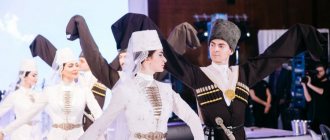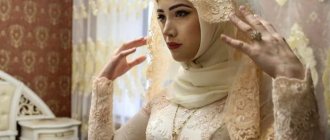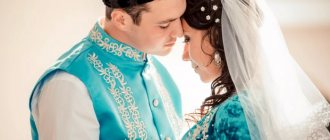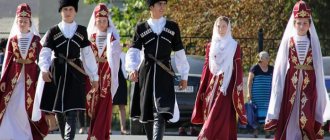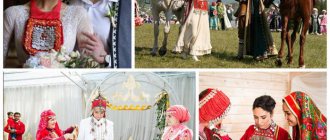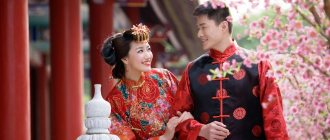The culture of each nation is unique and inimitable in its own way. The traditions and beliefs that determine the way of life of different ethnic groups, even within the same country, can differ dramatically. They agree on one thing: the birth of a new family is always celebrated on a grand scale, and the wedding itself is preceded by a long preparatory period. Rituals carried out during marriage celebrations are aimed at increasing the welfare of the newly created family and the birth of healthy, numerous children. An Udmurt wedding is a bright event in the original folk style, carried out in compliance with national beliefs and customs.
Ancient marriage traditions of the Udmurt people
The Udmurts are a small ethnic group living in the Kama region. The first tribes appeared in this territory ten thousand years ago, and written sources about the Udmurts go back a thousand years. This people carefully preserved their original way of life. Despite the influence of the culture of other peoples and the Orthodox faith, many rituals have been observed since pagan times to this day.
Modern life makes its own adjustments; this cannot be avoided. Udmurtia, like all republics of the Russian Federation, keeps pace with the times. Some customs are outdated and almost forgotten; only ethnographers and old people from remote villages remember them. Something has lost its meaning, discarded as unnecessary. But the time-honored basis of the marriage ceremony is revered and strictly observed. The ritual of the unity of a man and a woman to create a new family reveals the unique flavor of primordially Udmurt customs.
Despite the pagan roots, the influence of the Orthodox faith on the culture of the Udmurts is great. Weddings in Udmurtia , as a rule, were timed to coincide with major Christian holidays. The summer period was considered an extremely unfavorable time for marriage; work in villages in the summer was no end of the land.
As soon as the harvest was over, weddings began to thunder in all villages, this time is from mid-October to mid-November. Getting married during this period was considered the most favorable omen. The wedding, blessed by the abundant harvest of the past year, promised a prosperous, satisfying life and numerous offspring. And in winter it was customary to get married, starting from Epiphany, January 19, until the spring Maslenitsa. Wednesday, Friday and Sunday were considered forbidden days.
A feature of the ancient Udmurt wedding is the long breaks between stages of the ceremony. Often, they lasted for several months. In this unusual way, families and those getting married themselves were given time to gather their courage and prepare for the next complex action in a whole series of rituals.
Housing
A traditional Udmurt house has similar features to a Finno-Ugric dwelling. Locals call it "koda". Later, the Udmurts began to live in huts, which included a vestibule. A gur, an adobe oven, was always placed inside the hut. Next to the stove there was a red corner where a table and chairs were placed. The most beautiful was intended for the guest of honor or the head of the family. Benches were placed along the walls and shelves called zhazhi were placed above them. They hid the dishes in the closet and slept on bunks. Now many modern houses are being built in Udmurtia, but the population strives to preserve traditional decoration. In almost every house you can find carpets on the walls, a lot of towels (chushkon-turban), which decorate benches, chests, and window sills. In the old fashioned way, curtains made of chintz and embroidered with national patterns are hung on the windows.
Bride selection period and matchmaking
All issues regarding dating and marriage were decided by older family members. Girl brides who had reached marriageable age did not have the right to vote. Often, no one asked the young groom either. They started looking for a bride for their son when he turned 13-14 years old, and the most suitable age for marriage was considered 16-18 years old. The future wife had to be healthy, hard-working, calm in character, and not crippled.
The girl's skills and abilities were carefully assessed, as well as the well-being of her relatives and the amount of the dowry. There should not be any damaging rumors about the girl. Very often the bride was 2-6 years older than the groom. The reasons for such decisions are purely practical: the farm needed workers. A teenage girl still needed to be trained, but it is unknown what kind of housewife she would have made. However, the girls’ parents were in no hurry to marry them off - all for the same reasons.
Relatives and acquaintances were actively involved in the search for a suitable candidate. Recommendations could be given, if necessary, by mature married ladies who carefully studied potential brides. Such women were called demchi - matchmakers. Recognized demchi provided comprehensive information on the candidates, including their character, preferences, integrity, hard work, a complete description of all relatives, as well as their income.
As soon as the candidacy was approved by the family council, preparations were made for matchmaking. The matchmaker was the groom's father, the demchi, and selected members of the immediate family. The matchmaker started the conversation, using colorful allegories, and sometimes even in poetry, describing the merits of such a successful match for their daughter. But the bride's parents remained steadfast. No one was able to get a positive answer right off the bat.
The unsuccessful matchmakers took their leave, forgetting something of their clothing, usually mittens or a belt. They returned for the loss a few days later and started the same song again. Sometimes I had to “forget” five or six times. When the bride's relatives finally came to terms with the thought of a quick farewell to their little blood, a samovar heated by the bride and fragrant tea awaited the driven matchmakers.
If the relatives categorically did not agree to the proposed party, the girl defiantly pulled the tablecloth off the table, running out of the house.
It was at the table that the size of the yyrdon, the bride price, the dowry of the chosen beauty and the accounting of joint expenses for celebrations were discussed. Long and very difficult negotiations ended in mutual agreement, when the smallest details, down to the bride’s attire and the number of towels in the dowry, were taken into account.
The matchmaking ended with a presented loaf with a bowl full of butter on it. This right was usually granted to the mother of the bride or the eldest woman in the house. A representative of the happy groom threw silver coins into the oil, marking the girl's transition to the status of an official bride.
Character
For many years, Udmurtia was an autonomous region, so its residents felt independent. The main economy has always been connected with the forest, which, according to the Udmurts themselves, influenced their character. Many people think of the Udmurts as calm, even slightly phlegmatic people. Many people worry about the opinions of others, but never get into arguments. Since ancient times, Udmurts have considered starting hostility to be a grave sin. Often people appear closed, shy and reserved. In relation to each other, on the contrary, they are open, sociable, and emotional.
Wedding preparations
Relatives on both sides prepared separately. At their own discretion, they purchased and prepared food for the festive table, sewed and bought outfits and decorations. Livestock was slaughtered and the agreed upon dowry and dowry were prepared. All the best was given - the wedding was supposed to demonstrate the wealth of the family, the wealth of the groom and the beauty of the bride, as well as the cohesion of their relatives.
It was customary to personally invite invited relatives, friends and respected people to the holiday - this is a sign of the highest respect. Basically, this was done by the male part of the family, since women had enough trouble with preparation.
Life
Agriculture and animal husbandry became the main occupations for the ancient Udmurts. Fertile soils were suitable for growing a variety of crops; people could afford to constantly eat berries and vegetables. Men were engaged in hunting, fishing, and beekeeping. The proximity to the forest made it possible to quickly get hold of the animal and feed the family to the full. The Udmurts early managed to master timber harvesting, woodworking, weaving, knitting, and embroidery. Clothes were made at home and some were sold. In the 18th century, industrial development began. The population switched to production, leaving traditional crafts. To this day, part of the population of Udmurtia is employed in the manufacturing sector, but some continue the work of their ancestors.
Wedding ceremony
The ceremonial rituals of marriage were conventionally divided into two parts. First, the holiday took place in the bride’s house, then everyone went together to the groom’s, where the rituals and feast continued. However, if the girl was taken away from her father’s house immediately after reaching an agreement, the celebration began with the newlywed’s parents.
Xuan - celebration at the bride's house
The groom's relatives equipped the wedding train, consisting of many horse-drawn carts. The train was decorated as richly as possible, including the harness. Ribbons, flowers, metal and precious monistas, and rings were tied. The groom was accompanied by the remaining relatives in the house, giving humorous and serious instructions. The poezzhans, as the participants in the procession were called, chose from among their number the most respected man who would lead the parade procession and officiate at the wedding. Demi's presence was mandatory.
The chosen one’s relatives did not take part in the trip. Their duty was to help organize the feast, meet and treat the guests. The house was luxuriously decorated for the arrival of guests. All accessible surfaces were covered with ceremonial tablecloths and tapestries, windows and mirrors were framed with embroidered towels. Pickles, cold meat, bread and homemade cakes were served on the table.
Travelers were greeted at the gate, offered a drink from the threshold - kumyshka, a national strong drink, flat cakes or brushwood. Anyone who didn’t take at least a bite was not allowed into the yard. The leaders of the celebrations were introduced and then seated at the table. Long songs began until the very end of the feast. It was in the songs that all the advantages of the bride and groom were described, thus introducing the newlyweds to each other and new relatives. Having sung everything that could be said about the newlyweds, the guests and hosts sang farewell songs and gathered the bride. Prepared gifts were presented.
Yarashon - celebration in the groom's house
Yarashon was prescribed, as a rule, after several days or weeks. If Xuan was celebrated at Christmas, then the next stage was scheduled for Maslenitsa. The festive cortege was supposed to visit the homes of relatives and respected people, and they always stopped by the wedding planner. In every house they were treated to a treat, they were taught ritual songs, and they were given instructions for a prosperous life. At the same time, the newlyweds did not perform any songs themselves.
Somewhere during the trip, the newlywed disappeared. The inconsolable groom had to find her. The feast continued at the groom's house. When a girl entered the territory, a pillow was thrown at her feet - so that her character would be soft and accommodating.
The final day of the celebration was marked by a masquerade. The more bizarre the image presented, the merrier. The residents said goodbye to the newlyweds, trying with all their might to bring the young woman to tears. It was considered a good omen that if she cried, the less sorrow she would have in the future.
The wedding night
The chosen one was met by her mother-in-law and escorted to the women's quarters. There she unbraided her girl’s braid, did a woman’s hairstyle and put on a turban, which from now on the married woman had to wear all the time. After this, the newlyweds were left for their first wedding night, with a canopy woven by the bride wrapped around their bed.
Interesting customs of the Udmurt wedding
Each nation has its own original small customs and signs regarding marriage. The Udmurts are no exception.
- Matchmakers had to carry selected snuff with them. If the father of the bride likes him, the consent is in his pocket.
- Both parents were not supposed to take part in matchmaking, only the father or older relative, and in their absence, the mother.
- One of the original customs of the Udmurts is the opportunity to take the arranged bride to the groom’s house immediately after the matchmaking is over.
- The girl herself had to embroider the canopy that covered the newlyweds’ bed.
- In order for the newlyweds to be released from the house of the girl's parents, the groom had to pay a ransom.
- When the bride was preparing tabani - yeast pancakes in the groom's house, the groom's groomsmen disturbed her in every possible way, closing the dampers in the oven, turning the work into a fun game. To stop the outrage, the guys were given drinks.
- The main rituals were the dressing of the bride in her husband's house, when she was dressed in a woman's headscarf, and bathing, when the girl was doused with water from buckets the morning after her wedding night.
- The owners of the house could demand a barrel of kumyshka, and the same one that was made for the birth of the newlywed.
All customs at an Udmurt wedding had a deep ritual significance, or contributed to the creation of the necessary mood. Still, the transition from one family to another is a very difficult period.
Appearance
Most Udmurts are red-haired. The cheeks are naturally sunken, and freckles can often be seen on the faces. Professor Nikolai Nikolsky noted that most Udmurts have strong white teeth, a sharp chin, a yellowish complexion, and narrow eyes.
Cloth
The main materials for the manufacture of national clothing of Udmurtia are:
- canvas
- cloth
- sheepskin.
Women wore a tunic-like canvas shirt, and over it they put on a white robe, which was belted. If it was necessary to dress warmer, they wore a camisole. For legs - pants. Clothes were usually colored, and on a holiday people wore white. Shoes were felt boots or bast shoes. Embroidery made it possible to decorate clothes with ornaments at your own discretion; women loved to embroider outfits with beads and decorate themselves with beads, and in the south, coins were especially popular. Married women were required to wear a bandage on their forehead. The main headdress was a birch bark cap. It was also decorated with coins, less often with shells. Men wore a tunic-like shirt with a slanted collar. They belted it, put trousers on their feet, put a felted hat on their head, and walked in bast shoes or boots. Fur coats have long been common, protecting from the cold and allowing one to show one’s status. Now ethnic fashion has not lost its former popularity, having mixed with modern European style.
Entering a new life
In the morning, the tests of the newly-made wife began. She had to demonstrate her dowry, which her new relatives meticulously assessed. And also - to convince everyone of your culinary and household skills. The girl had to prepare a meal for guests and relatives on her husband’s side and complete household tasks. Then everyone went to the river, where the ritual of ablution was performed, the young woman threw a silver coin into the water and drew water. This water was used to prepare food for the guests.
The bride's relatives could visit the bride only a few days later. The young wife could not even visit her parents without being accompanied by her husband or mother-in-law. The following months after the wedding were marked by visits to numerous relatives. This is how the young wife was introduced to her new relatives. The cattle intended for the dowry were collected in the first autumn after the wedding. And this action completed the wedding ritual.
Culture
Udmurt music is divided into song and instrumental styles. In turn, song can be ritual, non-ritual and ritual. The Udmurt people dedicated songs to literally every phenomenon, for example, hunting, beekeeping, weddings, agriculture, and the change of seasons. People composed songs dedicated to hard labor and recruitment. The influence of the Scythians, Indo-Iranians, Byzantines, Finns and Russians can be traced. The love of music gradually led to its popularization in the field of education - children from school studied notes, sang in choirs and participated in balls. In the mid-19th century, the population began to become interested in the works of Pushkin, Gogol and other Russian writers. Theater appeared in Udmurtia thanks to ancient religious cults that professed syncretism - an extremely difficult to understand religion, full of abstractionism. Theatrical scenes among the ancient Udmurts rather served as rituals. Performances were staged right in the fields, houses or clearings. The scenes were not just rituals, but sought to show the plot and its development. Many stage productions talked about matriarchy and patriarchy, subsequently giving way to pure acting. The unusual idea of theater found a response in the hearts of many people, so theater groups went on tour throughout the country. At the beginning of the 20th century, theaters in Udmurtia began staging plays based on plays by famous Russian writers. Udmurt folk poetry became known in Russia thanks to Vereshchagin, Pervukhin, Gavrilov and others. Many Udmurt poets talked about everyday life, life, difficulties, and could be of a social-lyrical, heroic, or epic nature. A lot of literature is devoted to mythology.
Folklore
The Udmurt people have always had a developed folklore, serving as a source of wisdom and self-knowledge. Folklore was not divided into genres; it included material, religious and ethical culture. Many folklore works were dedicated to rituals and magic, choreography, and music. Through folklore, people turned to nature, cursed, took oaths, and congratulated. Folklore told about harvesting, crossing, treatment, even collecting water. A certain shamanism, the basis of which was healing words, spread among the Udmurts. Belief in conspiracies literally permeated people's lives. There were conspiracies against fever, wounds, and the evil eye. The most important were considered to be economic conspiracies that would bring benefit and prosperity to the home. Folklore contains many melodies that were dedicated to seeing off ice, round dances, the arrival of the first spring holiday, and the arrival of guests. As a result, folklore, whatever it was, told about all aspects of life. It is not for nothing that the Udmurts themselves say that it was composed according to the principle “I will tell and sing about what I see.” Many folklore works have become epics, retellings, fairy tales and short stories. It is interesting that the epic and retelling were taken at face value. Folklore also had an instructive meaning. He talked about taboos, cited sayings, proverbs, and taught us about signs.
Modern wedding in Udmurtia
Much has changed in ancient customs over time. The changes have become especially noticeable in recent decades. What are the most significant differences?
- The girl is given the right to independently choose her beloved; she can agree to an arranged marriage or refuse. Although, traditionally, girls still listen to the opinions of their relatives.
- In cities, the custom of matchmaking with multiple visits has almost ceased to be observed, and snuff has not been used for a long time.
- Weddings are celebrated in one go, without multi-week ceremonies.
The creation of a new family is always a holiday full of the most vivid emotions. An Udmurt wedding, in compliance with ancient customs, is filled with deep meaning and can tell a lot about the way of life of this people.
Here is a video that shows what kind of dowry the Udmurts had and how the outfits were created.
Religion
The main religion of Udmurtia is Orthodoxy. Some residents of the republic remain committed to paganism. One of the main gods of the Udmurt pagans is Inmar, personifying the sky. Since ancient times, the Udmurts were inclined to deify weather and fertility, because all this played an important role in their life. In addition to gods, Udmurt mythology includes many beliefs related to spirits. Pagans believe that almost everything has spirits: the forest, the forest, the wind, the barn, the field. Faith in brownies remains. Inmar's opponent is Keremet, considered an evil spirit. The prayer must be read in front of the kuala - a cult pedestal that is located in the courtyard. The spirit that patronizes the entire family lives in the pedestal. The spirit must be presented with bread, poultry, pancakes, burning the gifts on fire. All gods should be honored by praying regularly during the festival. The priests read prayers, asking for good weather, harvest, and prosperity for all village residents. For every religious holiday, porridge was prepared using various grains that were collected from all residents. Broth, melted butter, and chicken eggs were added to the porridge. They presented the porridge to the gods, then ate it themselves. Believers in paganism are required to visit the sacred grove, where they also need to pray. The sacred grove was intended exclusively for prayer - it was forbidden to graze cattle, pick berries, or cut down trees. Believing in the lower gods, the Udmurts bury gifts under the roots of the sacred tree. At its top they placed benefits for the upper gods. Birds and animals are sacrificed to them. Paganism clearly shares the position of rituals:
- In the spring and summer it was supposed to ask for a blessing on the harvest.
- In autumn-winter - give thanks and ask for prosperity for the coming year.
- During the New Year celebration, one must again ask for blessings on the harvest.
All residents of Udmurtia participate in folk festivities associated with ancient religious rituals. For example, Maslenitsa, Easter, called Akashka, and Gyron, associated with the end of arable work, are always popular. Children are told about Tol Babai - Father Frost, who has his own estate. Many children are taken to her every year, not only from Udmurtia itself, but also from neighboring regions. In Tol Babai's house he is waiting for guests, preparing pancakes in the oven.
Food
Thanks to well-established agriculture, the people of Udmurtia managed to obtain a variety of crops. People have always eaten food rich in minerals, vitamins, proteins, and microelements. The cuisine of Udmurtia is rich in cereals and legumes. Jelly is made from peas, koloboks are baked, and soups are made. Even children love peas, because they are a delicacy in Udmurtia - they are fried and candied. Compliance with traditions and a long-standing way of life are national features of Udmurt cuisine. As in ancient times, radishes, carrots, rutabaga, and cabbage are added to dishes here. The dough of the pies may seem bland - this is a specific feature of the flour dishes of the local cuisine. Bread is baked using rye and wheat. Bakery products are always held in high esteem. Tabani are considered the most beloved. These small sour dough cakes are devoured on both cheeks. Tabani is served with melted butter and sour cream, and sometimes salted cottage cheese is added. On a summer day, such a flatbread will be eaten with berries. Tabani is never consumed cold. The flatbread is only good when it is hot. Udmurt dumplings can be considered the most diverse dish. There are many recipes that delight you with their ingenuity. The filling can be almost anything: lamb, pork, radish, mushrooms, cottage cheese. Everything is limited only by the chef's imagination. Udmurts often stock up on dumplings for future use in winter. Many residents believe that they were the first to invent dumplings. In Izhevsk there is even a monument dedicated to dumplings. Perepechi is served on the holiday - this dish is somewhat reminiscent of pasties. The filling can include potatoes, radishes, cabbage, mushrooms, and chicken eggs. The most popular drink is sur. This is Udmurt kvass, to which hops, anise, and birch leaves are added. Sur is prepared with rye flour. It is also used for preparing bread moonshine.
The Udmurts are a rich people in every sense. Their unique culture attracts people from all over the world, so it is not surprising that the number of tourists seeking to visit the republic is constantly growing. Preserving a traditional way of life is certainly a strange phenomenon these days. That's why so many people come here to see how one of the oldest peoples lived.
